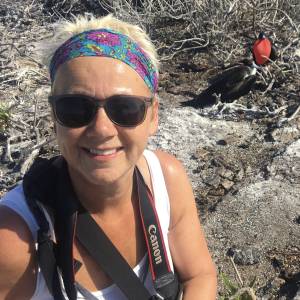Cape Gannets
Second posting of the day in my attempt to catch up! (First is our visit to Columbine National Park yesterday)
Today we move on to the Cederberg mountains. We leave Paternoster after, stopping off at the West Coast Fossil Park. Once a phosphate mine, fossils were discovered here in 1958, though mining continued until the 1990s. A remarkable number of different fossil animal species (and families) are represented at this site, making the area one ‘of the most diverse Mio-Pliocene occurrences in the world.’.
There is an exhibition hall, and plenty of information, but relatively few fossils are on display. It’s interesting, but I can’t help feeling they could have made far more of this. It certainly won’t be listed as one of the outstanding places we’ve ever visited!
The drive north takes us close to Lambert’s Bay, and as I’ve heard of a colony of Cape gannets on an offshore island, I’m keen to explore! By now it’s very cloudy and slightly misty, and Lambert’s Bay does not seem very promising. I’m not convinced this will be a profitable detour, or even whether the gannets have returned for the breeding season - the whole place seems rather desolate. But then I spot a little caravan that seems to be selling tickets, and having purchased ours we make our way along the causeway/breakwater to Bird Island.
Now it’s no secret that I love gannets, and not having been to Bempton this year, this visit does much to make up for it. But these are Cape gannets - slightly smaller than Northern and far fewer in number. Their heads are more yellow, and their tail feathers predominantly black - and viewing this colony is a totally different experience!
There are no cliffs here, no soaring flights up,to the cliff edge or down to nesting ledges. Here huge numbers of birds nest close together, a mass of yellow heads and sharp grey beaks, constantly chattering and moving. It’s still early in the breeding season, but there’s plenty of mutual sky pointing and grooming.
There is a hide, but there’s plenty don’t appear to be any openings for photography. Instead the viewing area is just a few metres from the birds, and between us and them is the ‘takeoff strip’. Unable to catch an uplift from the cliff ledges, these birds have to line up before running, gathering speed until they leave the ground. It’s fascinating - and amusing - to watch.
Landing is another matter entirely. There is no landing runway; instead, birds aim to return to their partners and nesting spots amongst the avian hordes. Having a large airborne gannet suddenly descending next to you must be annoying to say the very least, and it seems there’s a sort of pre-warning as they fly over ‘their’ patch with warning cries, before flying round to make their actual landing.
Instead of the usually pristine feathers of Bempton gannets, many of these birds look far from clean - the close proximity of other nest sites and their use of soil for nesting probably the cause. And I must confess, these distinctly unkempt specimens do lack elements of typical gannet charm.
It’s amazing how quiet it is - in human terms that is, as there is a cacophony of cries and shrieks from the colony. There’s just me and another photographer - G decides to walk around the island. It’s such an unexpected treat!
Tearing myself away, we continue on our journey, heading inland away from sea mist and into sunshine. The landscape is becoming completely different, hilly with rocky outcrops. Before long, we reach the beautiful Cederberg Wilderness Lodge, our home for the next two nights.
Our room opens out onto uninterrupted views up to the mountains - bliss. And it’s so nice to have an on site restaurant so the effort is minimal and the food excellent. During dinner, we’re asked what activities we’d like to take part in tomorrow. We opt for a hike to see the San rock art in the area, and G also goes for a sunset hike which I’m less convinced about!
We walk back to our room through near darkness, arriving to find our wood burning stove has been lit and our room is beautifully warm.
My main shows a gannet trying to land amidst the masses, with the usual assortment of extras - including one showing the stages of a very clumsy take off!




Comments
Sign in or get an account to comment.


